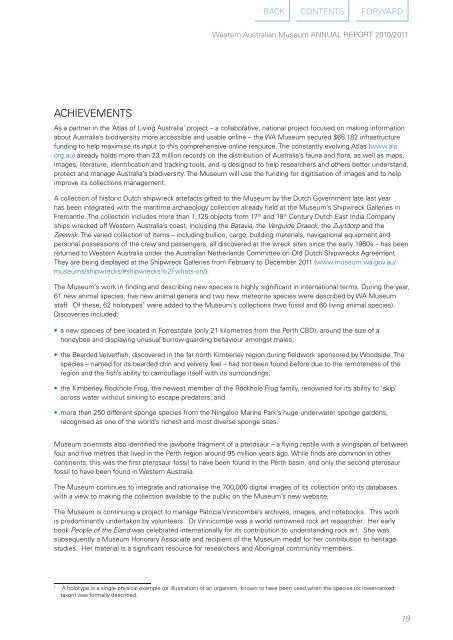Annual Report 2010-2011 - Western Australian Museum
Annual Report 2010-2011 - Western Australian Museum
Annual Report 2010-2011 - Western Australian Museum
Create successful ePaper yourself
Turn your PDF publications into a flip-book with our unique Google optimized e-Paper software.
ACHIEVEMENTS<br />
BACK CONTENTS FORWARD<br />
<strong>Western</strong> <strong>Australian</strong> <strong>Museum</strong> ANNUAL REPORT <strong>2010</strong>/<strong>2011</strong><br />
As a partner in the ‘Atlas of Living Australia’ project – a collaborative, national project focused on making information<br />
about Australia’s biodiversity more accessible and usable online – the WA <strong>Museum</strong> secured $68,182 infrastructure<br />
funding to help maximise its input to this comprehensive online resource. The constantly evolving Atlas (www.ala.<br />
org.au) already holds more than 23 million records on the distribution of Australia’s fauna and flora, as well as maps,<br />
images, literature, identification and tracking tools, and is designed to help researchers and others better understand,<br />
protect and manage Australia’s biodiversity. The <strong>Museum</strong> will use the funding for digitisation of images and to help<br />
improve its collections management.<br />
A collection of historic Dutch shipwreck artefacts gifted to the <strong>Museum</strong> by the Dutch Government late last year<br />
has been integrated with the maritime archaeology collection already held at the <strong>Museum</strong>’s Shipwreck Galleries in<br />
Fremantle. The collection includes more than 1,125 objects from 17 th and 18 th Century Dutch East India Company<br />
ships wrecked off <strong>Western</strong> Australia’s coast, including the Batavia, the Vergulde Draeck, the Zuytdorp and the<br />
Zeewijk. The varied collection of items – including bullion, cargo, building materials, navigational equipment and<br />
personal possessions of the crew and passengers, all discovered at the wreck sites since the early 1960s – has been<br />
returned to <strong>Western</strong> Australia under the <strong>Australian</strong> Netherlands Committee on Old Dutch Shipwrecks Agreement.<br />
They are being displayed at the Shipwreck Galleries from February to December <strong>2011</strong> (www.museum.wa.gov.au/<br />
museums/shipwrecks/#shipwrecks%2Fwhats-on/).<br />
The <strong>Museum</strong>’s work in finding and describing new species is highly significant in international terms. During the year,<br />
61 new animal species, five new animal genera and two new meteorite species were described by WA <strong>Museum</strong><br />
staff. Of these, 62 holotypes 1 were added to the <strong>Museum</strong>’s collections (two fossil and 60 living animal species).<br />
Discoveries included:<br />
• a new species of bee located in Forrestdale (only 21 kilometres from the Perth CBD), around the size of a<br />
honeybee and displaying unusual burrow-guarding behaviour amongst males;<br />
• the Bearded Velvetfish, discovered in the far north Kimberley region during fieldwork sponsored by Woodside. The<br />
species – named for its bearded chin and velvety feel – had not been found before due to the remoteness of the<br />
region and the fish’s ability to camouflage itself with its surroundings;<br />
• the Kimberley Rockhole Frog, the newest member of the Rockhole Frog family, renowned for its ability to ‘skip’<br />
across water without sinking to escape predators; and<br />
• more than 250 different sponge species from the Ningaloo Marine Park’s huge underwater sponge gardens,<br />
recognised as one of the world’s richest and most diverse sponge sites.<br />
<strong>Museum</strong> scientists also identified the jawbone fragment of a pterosaur – a flying reptile with a wingspan of between<br />
four and five metres that lived in the Perth region around 95 million years ago. While finds are common in other<br />
continents, this was the first pterosaur fossil to have been found in the Perth basin, and only the second pterosaur<br />
fossil to have been found in <strong>Western</strong> Australia.<br />
The <strong>Museum</strong> continues to integrate and rationalise the 700,000 digital images of its collection onto its databases<br />
with a view to making the collection available to the public on the <strong>Museum</strong>’s new website.<br />
The <strong>Museum</strong> is continuing a project to manage Patricia Vinnicombe’s archives, images, and notebooks. This work<br />
is predominantly undertaken by volunteers. Dr Vinnicombe was a world renowned rock art researcher. Her early<br />
book People of the Eland was celebrated internationally for its contribution to understanding rock art. She was<br />
subsequently a <strong>Museum</strong> Honorary Associate and recipient of the <strong>Museum</strong> medal for her contribution to heritage<br />
studies. Her material is a significant resource for researchers and Aboriginal community members.<br />
1 A holotype is a single physical example (or illustration) of an organism, known to have been used when the species (or lower-ranked<br />
taxon) was formally described.<br />
19
















